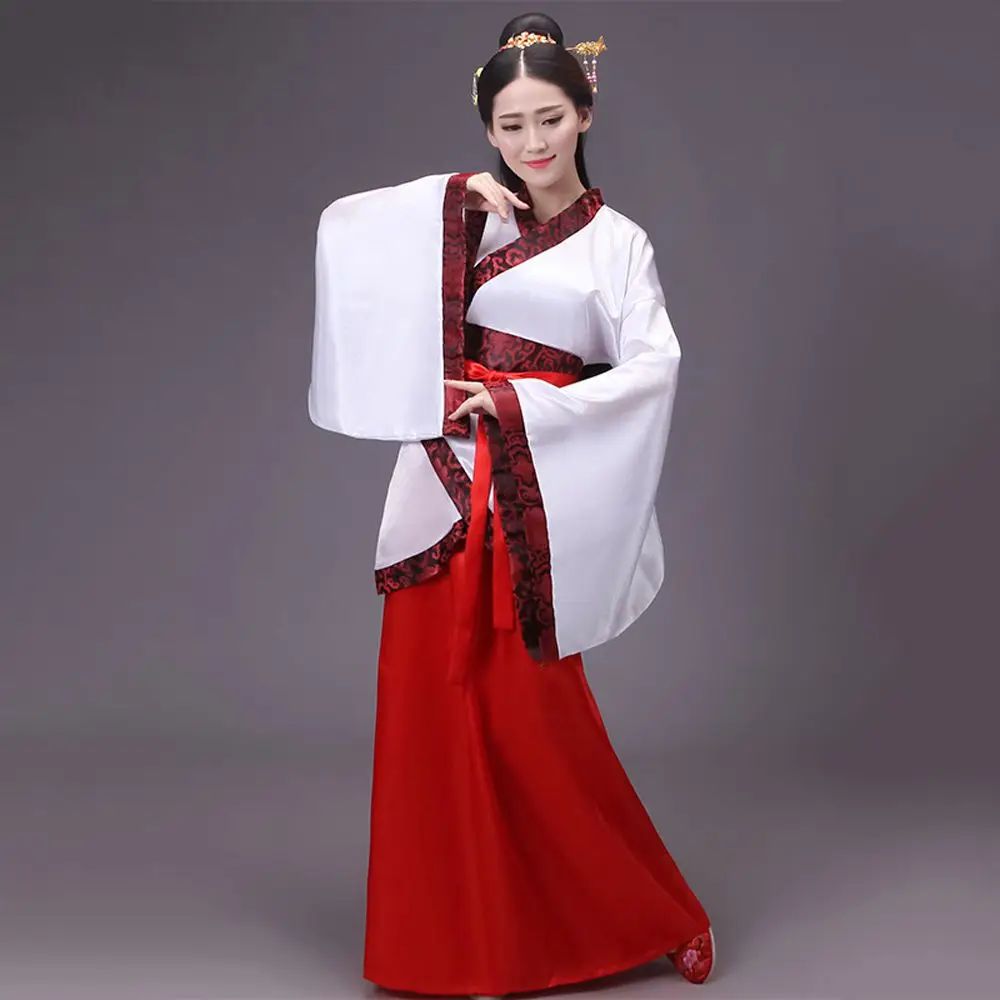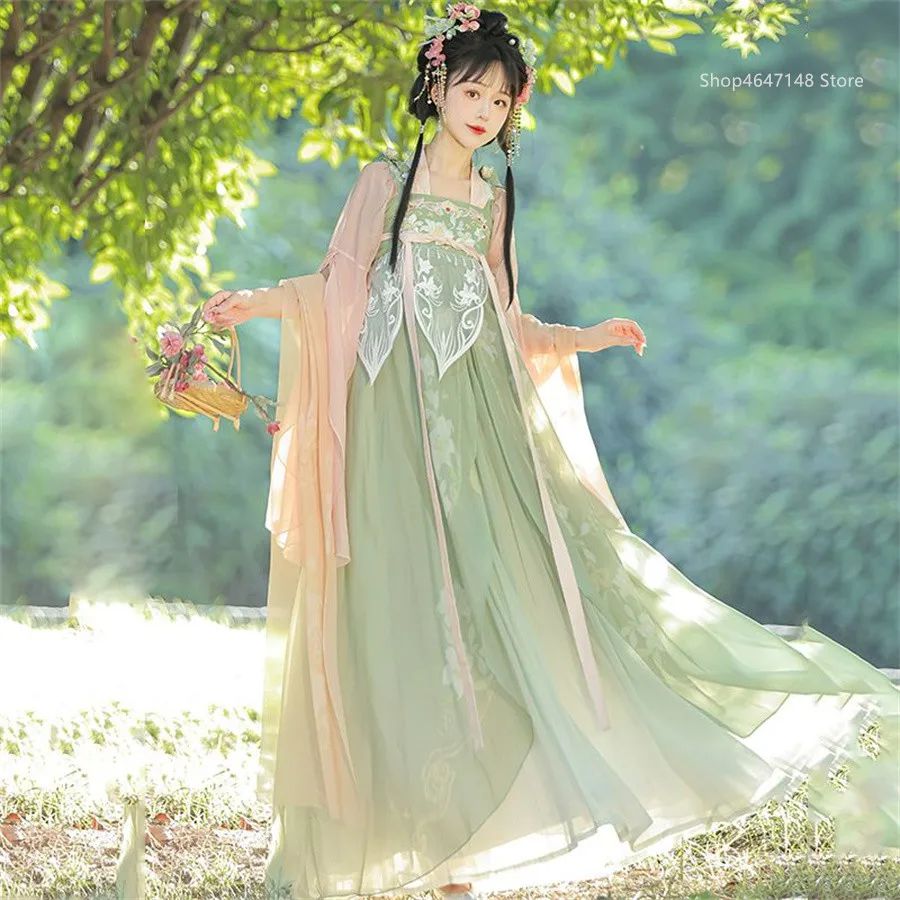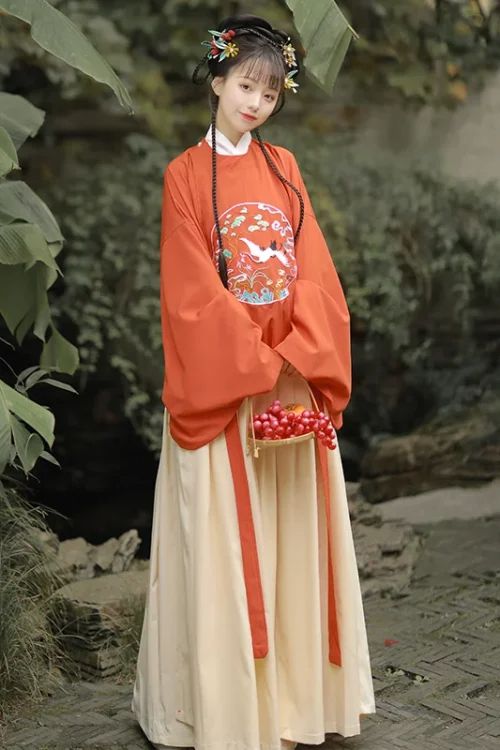The Influence of Confucianism on 汉服 Patterns
The evolution of patterns on Hanfu, the traditional clothing of the Han Chinese, is closely intertwined with the profound influence of Confucianism. Confucianism, a system of ethical and philosophical teachings, has shaped Chinese culture for centuries, and its principles have been reflected in the design and symbolism of Hanfu patterns.
Han Dynasty Developments
During the Han dynasty (206 BCE – 220 CE), Confucianism gained prominence as the guiding ideology of the empire. This period witnessed the emergence of elaborate and intricate patterns on Hanfu, often featuring auspicious symbols and motifs. The “Twelve Ornaments,” a set of auspicious patterns representing virtues such as benevolence, righteousness, and wisdom, became prevalent on Hanfu. These patterns were believed to bring good fortune and protection to the wearer.

Tang Dynasty Refinements
As Confucianism continued to flourish during the Tang dynasty (618 – 907 CE), Hanfu patterns became more refined and elegant. The “Eight Trigrams,” a set of symbols representing the fundamental principles of the universe, were often incorporated into Hanfu designs. These patterns symbolized harmony and balance, reflecting the Confucian emphasis on order and propriety.

Song Dynasty Subduing
During the Song dynasty (960 – 1279 CE), Confucianism underwent a revival, and Hanfu patterns became more subdued and understated. The “Four Gentlemen,” a group of plants representing integrity, perseverance, humility, and purity, became popular motifs on Hanfu. These patterns embodied the Confucian virtues of self-cultivation and moral excellence.

Ming Dynasty Authority
In the Ming dynasty (1368 – 1644 CE), Confucianism remained a central pillar of society, and Hanfu patterns continued to reflect its teachings. The “Nine Dragons,” a symbol of imperial authority and power, were often featured on the robes of officials and the emperor. These patterns represented the Confucian belief in a hierarchical social order and the importance of respecting authority.

Qing Dynasty Cohesion
Throughout the Qing dynasty (1644 – 1912 CE), Confucianism continued to influence Hanfu patterns, albeit to a lesser extent. The “Hundred Birds,” a symbol of peace and harmony, became a popular motif on Hanfu. These patterns reflected the Confucian emphasis on social cohesion and the importance of living in harmony with nature.
结论
In conclusion, the evolution of patterns on Hanfu has been deeply influenced by Confucianism. The auspicious symbols, motifs, and patterns that adorn Hanfu reflect the Confucian principles of virtue, harmony, order, and self-cultivation. These patterns have served as a testament to the enduring influence of Confucianism on Chinese culture and have played a significant role in shaping the aesthetic and symbolic significance of Hanfu.
The Evolution of Hanfu Patterns from the Han to the Tang Dynasty
The evolution of patterns on Hanfu, the traditional clothing of the Han Chinese, reflects the cultural and artistic developments of different dynasties.
Han Dynasty Simplicity
During the Han Dynasty (206 BCE – 220 CE), Hanfu patterns were characterized by their simplicity and geometric designs. Common motifs included straight lines, circles, and squares, often arranged in symmetrical patterns. These patterns were often woven into the fabric or embroidered onto it using silk thread.
Three Kingdoms Period Variations
As the Han Dynasty transitioned into the Three Kingdoms period (220-280 CE), Hanfu patterns became more elaborate and varied. The use of color became more prominent, with vibrant hues such as red, green, and blue being incorporated into the designs. Additionally, new motifs emerged, including floral patterns, animal figures, and auspicious symbols. These patterns were often embroidered onto the fabric using a variety of stitches, creating a rich and textured effect.
Jin Dynasty Intricacies
During the Jin Dynasty (265-420 CE), Hanfu patterns continued to evolve, becoming even more intricate and sophisticated. The use of gold and silver thread became popular, adding a touch of luxury to the garments. Additionally, new techniques such as couching and appliqué were employed to create three-dimensional effects. These patterns were often inspired by nature, with motifs such as flowers, birds, and animals being commonly depicted.
Tang Dynasty Golden Age
The Tang Dynasty (618-907 CE) marked a golden age for Hanfu patterns. The garments of this period were renowned for their beauty and elegance, and the patterns were a major contributing factor. Tang Dynasty Hanfu patterns were characterized by their use of bright colors, bold designs, and a wide variety of motifs. Floral patterns were particularly popular, with peonies, lotuses, and chrysanthemums being common choices. Additionally, animal figures, such as dragons, phoenixes, and cranes, were often depicted in the patterns. These patterns were often woven into the fabric using a variety of techniques, including brocade, damask, and tapestry.
Cultural Reflections
The evolution of Hanfu patterns from the Han to the Tang Dynasty reflects the changing cultural and artistic tastes of the Chinese people. The patterns became increasingly elaborate and sophisticated over time, and the use of color and motifs became more varied. These patterns are a testament to the skill and creativity of Chinese artisans and continue to inspire designers and fashion enthusiasts today.
The Impact of Buddhism on Hanfu Patterns in the Song and Yuan Dynasties
The evolution of patterns on Hanfu, the traditional clothing of the Han Chinese, has been influenced by various factors throughout history. During the Song and Yuan dynasties, the introduction of Buddhism had a profound impact on Hanfu patterns, leading to the incorporation of Buddhist motifs and symbols.
Song Dynasty Flourishing
In the Song dynasty, Buddhism flourished, and its influence permeated various aspects of Chinese culture, including art and fashion. Buddhist monks and nuns wore distinctive robes adorned with intricate patterns, which gradually influenced the designs of secular Hanfu. Lotus flowers, a symbol of purity and enlightenment in Buddhism, became a popular motif on Hanfu. Other Buddhist symbols, such as the swastika and the vajra, also found their way into Hanfu patterns.
Yuan Dynasty Fusion
The Yuan dynasty, established by the Mongols, saw a continuation of Buddhist influence on Hanfu. However, the Mongol rulers also introduced their own cultural elements, leading to a fusion of styles. Hanfu patterns during this period often incorporated both Buddhist and Mongolian motifs. For example, the lotus flower was combined with the Mongolian cloud collar, creating a unique and eclectic design.
Aesthetic Influences
The impact of Buddhism on Hanfu patterns extended beyond religious symbolism. Buddhist principles of harmony and balance influenced the overall aesthetic of Hanfu. Patterns were carefully arranged to create a sense of symmetry and order, reflecting the Buddhist belief in the interconnectedness of all things.
Dyeing Techniques
Furthermore, the introduction of new dyeing techniques during the Song and Yuan dynasties allowed for a wider range of colors and patterns on Hanfu. The use of natural dyes, such as indigo and safflower, produced vibrant and long-lasting colors. This enabled artisans to create more elaborate and sophisticated patterns, further enhancing the beauty and elegance of Hanfu.
结论
In conclusion, the impact of Buddhism on Hanfu patterns in the Song and Yuan dynasties was significant. Buddhist motifs and symbols were incorporated into Hanfu designs, reflecting the growing influence of Buddhism in Chinese society. The fusion of Buddhist and Mongolian elements during the Yuan dynasty led to a unique and eclectic style. Moreover, the introduction of new dyeing techniques allowed for a wider range of colors and patterns, contributing to the overall beauty and sophistication of Hanfu.分享
